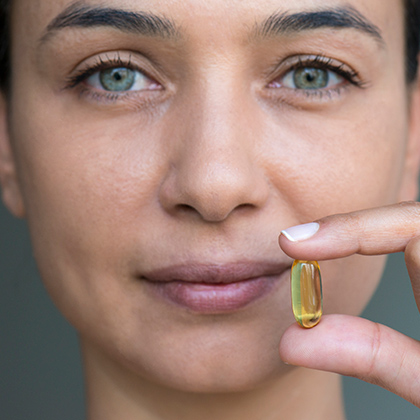
If your eyes feel tired and sore after reading for a long time, or if they ache when you’ve been checking your text messages for more than a few minutes, then it’s very likely that you’ve experienced eye strain. Asthenopia – the medical term for eye strain – is a group of symptoms that can be caused when you work your eyes intensively for prolonged periods of time. Whenever you focus on an object at a close distance —whether it’s your computer screen or a piece of intricate sewing – it can place strain on your eyes, causing them to feel uncomfortable. To help you understand a little more about what causes eye strain, as well as how to prevent it, we’ve put together this helpful guide.
What causes eye strain?
Eye strain is usually the result of the muscles in your eyes overexerting themselves. These muscles are called ciliary muscles, and they can become strained from overwork, just like any other muscle in your body. Intense visual concentration can strain other muscles too, including those in your eyelids, face, temples and jaw. The muscles in your eyes can also become tired easily if you have refractive errors – that is if you have a condition such as myopia (being shortsighted), hyperopia (being longsighted), or presbyopia, an age-related condition that makes focusing on close objects difficult.

Eye strain has also been associated with astigmatism, a condition which leaves the eye unable to focus light evenly onto the retina. Additionally, your eye muscles can also become strained if you have an imbalance between your eyes, which means your eyes find it difficult to align properly. Named binocular vision disorders, these can overwork the muscles that keep the eyes parallel, as the muscles have to work hard to prevent double vision. The good news is that eye strain doesn’t usually have any serious or long-term complications, and it should ease as soon as you stop overexerting your eyes.
What are the signs and symptoms?
While soreness and tiredness usually come at the top of the list, these aren’t the only symptoms of eye strain. Some of the other symptoms that can be a sign of eye strain include:
-
Headaches
-
Nausea
-
Blurred vision
-
Dry eyes
-
Red eyes
-
Sensitivity to light
-
Aching back or neck muscles
-
Muscle spasms (twitching eyes)
-
Difficulties reading
-
Poor concentration
-
Trouble focusing on small objects or details
Who is at risk of eye strain?
Although all of us experience eye strain at some point or another, certain people are more prone to experiencing strain and pain on a regular basis. If your working day is spent mostly behind a computer, or if you watch a lot of TV or use a smartphone or tablet for prolonged periods, your risk of developing eye strain symptoms may be high. Studies suggest 50 per cent or more computer users, for example, may be affected.i Often called computer vision syndrome or digital eyestrain, this type of eye strain is caused by excessive exposure to blue light in a certain wavelength. Spending lots of time using screens with a lot of screen glare or with poor contrast between the text and the background is also thought to contribute to eye strain. However, another reason screen use may tire your eyes is that using digital devices makes you blink less, which can lead to eye dryness and make eye strain worse. Understanding the impact that blue light has on your overall eye health can be the first step towards reducing eye strain. Meanwhile, if you’re older and spend a lot of time in front of a screen your risk may be even higher, as the risk of dry eye syndrome increases with age.
Computer users aren’t the only people with a high risk of developing eye strain, however. Other professions that involve hours of intensive reading or visual concentrating can also lead to significant eye strain. This includes professionals such as lawyers, proofreaders, accountants and drivers. Any job that’s carried out in dim light may also make your eyes tired and more prone to strain.
Ways to reduce eye strain
While you may not be able to change the nature of your job, there are a number of steps you can take to reduce the impact on your eyes.
Adjust your screen
Try to make sure your computer monitor is as easy on your eyes as possible. This could include turning down the brightness of your screen to match the lighting in the room, or improving the lighting in a dimly lit room to match the brightness of your device. You could also try adjusting the contrast of your screen to make text easier to read. On top of this, you should also try to reduce screen glare too, since glare is thought to be a major cause of eye strain. Anti-glare screen filters are available for computer monitors and smartphones, and if you wear glasses you may want to consider getting them fitted with lenses that have anti-reflective coatings. See our article for more advice on computer screen glare and eye health. Some screens also allow you to adjust their colour temperature, which can help reduce the amount of blue light they display. Increasing the font size on your computer or smartphone may also make a difference, as your eye muscles may not have to work so hard when reading larger text. Ensuring that your screen isn’t too close to you should also make your eyes feel more comfortable.
Take a break
Looking away from your screen regularly is a good idea to give your eye muscles a break. Try following the 20-20-20 rule, which means taking a 20-second break from your screen every 20 minutes and looking at something at least 20ft away. This can help the focusing muscles in your eyes relax, which can help relieve eye strain. Try using an app to remind you to take a break every 20 minutes. It’s also a good idea to take longer screen breaks throughout the day. If you’re busy, try to take at least four five-minute breaks during the day in addition to your usual lunch break. If your job isn’t so hectic, aim for a 15-minute break every two hours.
Keep your eyes hydrated
Staring at a digital screen can make you blink far less frequently than normal, which means you don’t produce enough tears to keep the surface of your eye sufficiently lubricated. If you feel your eyes becoming dry or tired, try to consciously blink more, or practice about 10 very slow blinks every 20 minutes or so. If that doesn’t help, you may need to use rehydrating eye drops, which are available at pharmacies.
Use heat
When your eyes are tired, warmth can help to revive them. Try using a warm compress: soak a clean cloth in warm water, wring it out then place over your eyes for a few minutes while you relax. Palming is also a technique that can apply warmth to your eyes. Rub your hands together until they feel warm, then place them over your eyes without applying any extra pressure. Let your eyes relax in the warmth for around 30 seconds and repeat whenever your eyes feel uncomfortable.
Nourish your eyes to health
Lutein and zeaxanthin
Lutein and zeaxanthin are plant pigments found together in a variety of foods such as green leafy vegetables, orange and yellow fruits and vegetables, as well as egg yolks. In recent years, there has been a large amount of research conducted into the potential for lutein and zeaxanthin to help maintain healthy vision. One group of researchers found that taking supplements containing lutein, zeaxanthin for six months may help improve eye strain, eye fatigue and the number of headaches in people who spend long periods in front of a computer screen.ii These nutrients can be easily integrated into your diet by increasing your intake of leafy greens like spinach, or through a high-quality supplement. Discover more about how lutein and zeaxanthin can assist with eye health in our article.
Astaxanthin
This is also a carotenoid pigment, found mainly in fish and shellfish such as salmon, rainbow trout, shrimp and crab. In one small-scale study, researchers found a 6mg dose of astaxanthin a day for four weeks may help relieve the symptoms of eye strain in middle-aged and older people with presbyopia.iii Easily increasing your shellfish intake is an easy way to boost your astaxanthin consumption, although this can also be found in supplement form.
Sea buckthorn
Used in traditional Chinese medicine for many years, sea buckthorn originates from high altitude regions of China and Russia, and produces berries rich in carotenoids as well as other phytonutrients called flavonoids. There is some evidence to suggest a sea buckthorn oil caplet may help improve dry eye symptoms by reducing tear film osmolarity, which is a mechanism thought to cause dry eye.iv
If, however, you’ve tried self-help measures, but they haven’t relieved your eye strain, talk to your optician as you may be straining your eyes because you need to wear glasses. As such, you should book regular eye tests – the NHS recommends most people get their eyes tested every two years.
As we’ve suggested, there are a number of measures that you can take to reduce the effects of strain on your eyes. For more helpful advice on a range of common eye conditions, feel free to visit our dedicated Vision Health Hub.
References:
-
Sheppard, A.L., Wolffsohn, J.W. Digital eye strain: prevalence, measurement and amelioration. BMJ Open Opthalmology Vol 3, issue 1. Available online: https://bmjophth.bmj.com/content/3/1/e000146l
-
Stringham, J.M., Stringham, N.T., O’Brien, K.J. Macular Carotenoid Supplementation Improves Visual Performance, Sleep Quality, and Adverse Physical Symptoms in Those with High Screen Time Exposure. Foods. (2017 Jun 29) ;6(7).
-
Kajita, M., Tsukahara, H., Kato, M. The effects of a dietary supplement containing astaxanthin on the accommodation function of the eye in middle-aged and older people. Med Consult New Remedies. (2009) ;46(3):89-937. Available online: http://www.flex-news-food.com/files/bioreal031209.pdf
-
Larmo, P.S., Jarvinen, R.L., et al. (2005) Oral sea buckthorn oil attenuates tear film osmolarity and symptoms in individuals with dry eye. 2010 Aug. ;140(8):1462-8. Available online: https://www.ncbi.nlm.nih.gov/pubmed/20554904
Related Posts?
Disclaimer: The information presented by Nature's Best is for informational purposes only. It is based on scientific studies (human, animal, or in vitro), clinical experience, or traditional usage as cited in each article. The results reported may not necessarily occur in all individuals. Self-treatment is not recommended for life-threatening conditions that require medical treatment under a doctor's care. For many of the conditions discussed, treatment with prescription or over the counter medication is also available. Consult your doctor, practitioner, and/or pharmacist for any health problem and before using any supplements or before making any changes in prescribed medications.

Christine
Christine Morgan has been a freelance health and wellbeing journalist for almost 20 years, having written for numerous publications including the Daily Mirror, S Magazine, Top Sante, Healthy, Woman & Home, Zest, Allergy, Healthy Times and Pregnancy & Birth; she has also edited several titles such as Women’ Health, Shine’s Real Health & Beauty and All About Health.
View More



